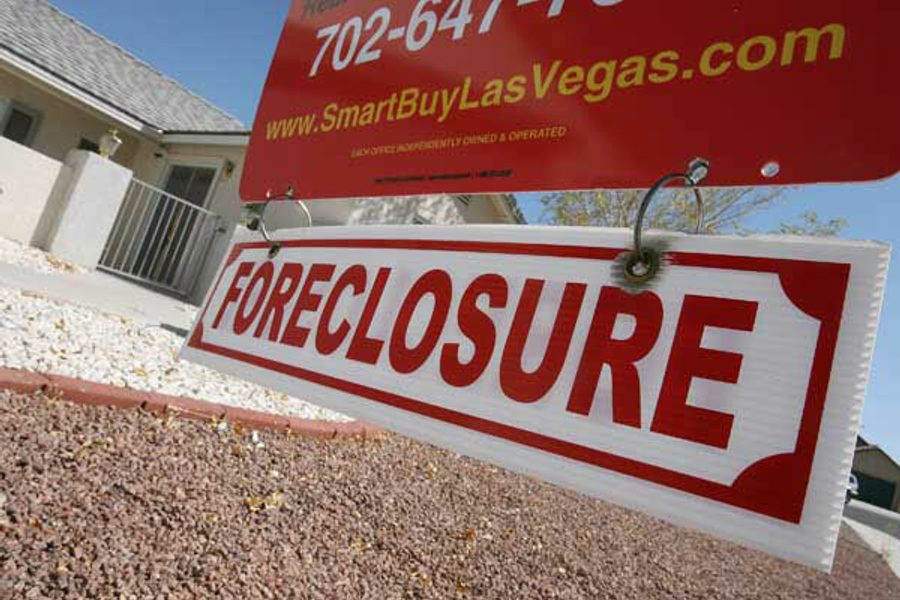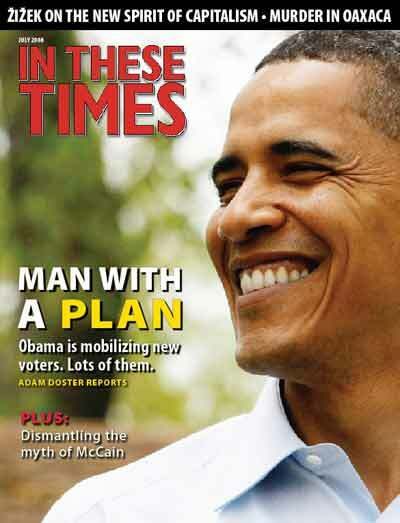Expand the Vote
The Obama campaign’s voter registration drive could radically alter the electoral map this fall
Adam Doster

Nineteen ninety-two was a crucial election year in Illinois. Arkansas Gov. Bill Clinton was hoping to carry a swing state that President George H.W. Bush had won by a scant 2 percentage points four years earlier, and Illinois’ Cook County Recorder of Deeds Carol Moseley Braun was attempting to become the nation’s first African-American female senator. Close observers believed that a swell in black turnout could make the difference in both contests, but activists feared that the leadership of Chicago’s Democratic Party – which historically hadn’t pushed registration in majority-black wards – would squander the opportunity.
In stepped a young organizer named Barack Obama. Fresh out of Harvard Law School, Obama moved to Chicago to head up the local branch of Project Vote, a D.C.-based non-partisan voter registration organization focused in low-income communities of color. Recruiting staff and volunteers from community groups and black churches, he helped train 700 deputy registrars and devised a comprehensive media campaign based around the slogan “It’s a Power Thing.” His volunteers hit the streets and registered more than 150,000 black voters in only six months. According to a 1993 report from Chicago magazine, the elections “turned on these totals.”
Sixteen years later, in the midst of his own presidential campaign, Sen. Barack Obama (D-Ill.) hasn’t forgotten the crucial lesson he learned canvassing Chicago’s South Side: Activating underrepresented communities can dramatically alter close elections.
Using his massive volunteer base, the one-time organizer is now adapting his Chicago experience for the national stage, leading similar targeted drives in all 50 states. Combined with his ability to inspire new voters and the continued efforts of long-established voter registration organizations, a registration boom could reconfigure the electoral map come November.
Why slice pie? Let’s grow it!
Lynne Schwartz, a veteran clinical psychologist based in Ann Arbor, Mich., was drawn to Obama well before he rose to national prominence. Schwartz focuses on juvenile justice reform, and Obama had led efforts in Chicago to combat legislation that would have put more juvenile offenders into the adult system. After reading his first book, watching him deliver his famous 2004 Democratic National Convention speech, and learning about his commitment to the Constitution and consensus-based problem solving, Schwartz knew she had found her candidate.
“I kept hearing him talking about healing the nation and repairing the world,” she says, “and I resonated with that at such a visceral level.”
When he announced his presidential candidacy, Schwartz jumped in, volunteering as the Washtenaw County organizer for the fledgling Michiganders for Obama. Although the Illinois senator wasn’t on the ballot in her state and had made no effort to campaign there, her organization pounded the sidewalks of Ann Arbor and Ypsilanti anyway, talking to voters about the confusing circumstances of their early primary and the value of voting “uncommitted.”
Their ground game paid off. “Uncommitted” received 45 percent in Washtenaw, beating the 43 percent Sen. Hillary Clinton (D-N.Y.) received in the county.
Following the primary, Schwartz stayed busy, phone banking from her personal computer, hosting local fundraisers, traveling to Ohio to canvass, and even winning a seat as a delegate to the national convention. But her biggest thrill came when the national campaign tapped her to run the local branch of the Vote for Change voter registration drive, a signal that the folks in Chicago were taking her organizing seriously.
Vote for Change is the latest iteration of the Obama campaign’s comprehensive electoral ground game, one that will build off the methodical and underreported registration efforts staged by Obama supporters during the primary season. Just in the late contests alone, campaign volunteers enlisted 200,000 new Democrats in Pennsylvania, 165,000 in North Carolina and more than 150,000 in Indiana.
“Recent voter registration drives conducted by our campaign have registered significant numbers of voters across this country,” says Obama spokeswoman Shannon Gilson. “We feel like this really scratches the surface of what’s possible.”
Launched in all 50 states on May 10, Vote for Change has been dispatching Obama staffers across the country to marshal volunteers through the campaign’s massive online database and train them in the basics of voter registration. Working with local organizers and using similar “micro-targeting” techniques honed by the GOP in the 2004 presidential campaign, Obama supporters will pepper precincts for the next six months in search of eligible but inactive political participants likely to value Obama’s message of change.
“It’s reaching out to our base of supporters,” says Gilson, “and empowering them to reach out into their communities to register their friends and neighbors.”
Chosen as one of the Vote for Change staging sites, Ann Arbor received a full-time organizer from the Obama campaign in late April, which Schwartz says has helped immensely with volunteer coordination and outreach.
“What has been outstanding and different from any other campaign that I’ve participated in has been the synergy,” says Schwartz. “It’s not like some campaign is coming in and the people doing the work on the ground for months are thrown under the bus. … They have a strong interest in our ideas and how we do things here.”
Following a successful kick-off on May 17, momentum in Washtenaw has been growing. Volunteer organizers have flooded Schwartz’s Wednesday planning meetings, each with their own list of potential targets and tactics. On the Saturday of Memorial Day weekend, 42 Obama supporters traveled to Ypsilanti and registered close to 100 people, many of whom have never voted.
Schwartz, who maintains she isn’t easily inspired, says she is continually stunned by both the professionalism of the national campaign and the enthusiasm local organizers bring to the work. “I go to work and I get home and there are new ideas being run by me that [are] just amazing,” she says. “There’s so much creativity and so much energy.”
Such enthusiasm will be needed to reach the campaign’s ambitious registration targets, which Gilson hinted would be in the millions. It helps that Obama has already won the support of many members of the voting rights community, who find his commitment to increasing the franchise refreshing.
“For many years, candidates … tended to compete for people who are already in the electorate, rather than expanding the electorate,” says Project Vote Deputy Director Michael Slater. “They thought of a slice of the pie rather than trying to grow the pie. So it’s interesting to see a candidate that is really talking about growing the size of the electorate.”
It’s not just Obama
While Obama’s drive has drawn attention for its distinctiveness among presidential contenders, focusing only on the campaign’s work neglects the crucial fieldwork that institutionalized voter registration organizations will be undertaking this cycle.
To be sure, controversy has embroiled a few high-profile operations. Last year, the Federal Election Commission (FEC) fined the now-disbanded America Coming Together $775,000 for raising contributions that violated federal limits. This cycle, the North Carolina attorney general ordered Women’s Voices, Women Vote to cease robo-calling voters with misleading messages after the primary registration date had passed.
But beyond those limited transgressions, a slew of successful organizations will ramp up their own efforts in the coming months.
Among them is Project Vote, Obama’s employer in 1992. Working in partnership with ACORN, the nation’s largest community organization of low- and moderate-income families, Project Vote orchestrates comprehensive drives targeted in low-income urban communities. Organizers are trained to canvass outside of locations where residents generally congregate – grocery stores, bus stops and religious institutions.
According to Slater, Project Vote registered more than 1 million voters in each of the last two cycles. Sticking to its time-tested formula, Project Vote has set a goal of 1.2 million new registrants.
Rock the Vote, the nation’s most recognizable youth registration outfit, has made encouraging advances in online registration, a tool that hasn’t matured as quickly as online political fundraising or organizing. Partnering with consumer rights organization Working Assets, Rock the Vote devised a voter registration widget – a portable application that political organizations, bloggers or candidates can embed on their websites using a simple HTML code.
Since last July, the widget has been added to 8,500 sites, and more than 600,000 young people have downloaded registration forms.
“What we do know is that registration is the biggest barrier to young people voting,” says Rock the Vote Communications Director Chrissy Faessen, “so the more young people we can get registered, the more we can send them out to the polls.”
Combined with its robust fieldwork, Faessen estimates that Rock the Vote could enlist 2 million new voters in this cycle.
The Poblano model
If winning elections is your primary focus, as is the case for most Obama volunteers, boosting registration levels is only as valuable as the votes it produces.
“About 64 million Americans are eligible to vote but are not registered to vote,” says Slater. “That’s about one-third of the entire voting-eligible population. So the opportunity to expand the electorate is there.”
Among underrepresented constituencies, the statistics are even starker. While the voting rate for young people between ages 18 and 24 shot up 11 percentage points from 2000 to 2004, the registration rate sits at a paltry 58 percent. It’s not much better for voters of color: African Americans (69 percent), Latinos (58 percent), and Asians (52 percent) all trail non-Hispanic white voters (75 percent). (If people of color were to vote at the same percentage as whites, there would be more than 5.5 million votes.)
Considering Obama’s success with much of these segments of the electorate, boosting turnout among young people and voters of color is where the Democratic nominee is most situated to broaden his base.
The “Poblano Model” best articulates the potential benefits of targeted voter mobilization. “Poblano” is Nate Silver, a formerly anonymous 30-year-old statistician, one-time DailyKos diarist and author of the website FiveThirtyEight.com. Silver has garnered considerable notoriety with his clever regression model – an electoral simulation engine that uses state-by-state polling data and demographic variables to predict election outcomes in individual states. Using the formula in early May, the blogger correctly projected the results of the critical primaries in Indiana and North Carolina, outperforming five major national polling operations.
In mid-May, Silver turned his attention to the general election, working with the Illinois-based political website Progress Illinois (Disclosure: I’m a reporter-blogger for the site but had no hand in the article) to examine how gradual increases in turnout among certain demographic groups might affect the outcome of an Obama-Sen. John McCain (R-Ariz.) presidential race. The results were instructive.
Consider Rock the Vote’s target audience. Silver estimates that boosting the youth vote by 25 percent nationwide would give Obama 16 additional electoral votes, mainly in the Upper Midwest (Iowa, Minnesota, Wisconsin) where youth turnout is historically high. A jump in Latino rates could play a key factor in the Mountain West states of Colorado, Nevada and New Mexico, as well.
But the African-American turnout could be the key to the election. According to average head-to-head polling numbers, blacks break for Obama at a 94 percent to 6 percent clip. With each 10 percent increase in black turnout nationwide, Obama gains an average of 13 electoral votes, while his chance of winning jumps by almost 7 percentage points.
The U.S. senator from Illinois stands to gain the most in battleground Rustbelt states like Michigan, Ohio and Pennsylvania, as well as in southern states – North Carolina and Virginia among them – where Democrats have struggled at the presidential level for decades.
“There are scenarios,” Silver told ProgressIllinois.com, “where you could really have – not a landslide – but Obama winning 350-plus electoral votes … just with a mild increase in African-American turnout.”
Like all electoral estimates, Silver’s analysis should be taken with a sizeable grain of salt. Polls this early in the process aren’t reliable and the regression model has its flaws. Being young and black isn’t mutually exclusive, a crossover that the simulation fails to address. But these numbers, coupled with Silver’s track record, should strike fear into the McCain camp, whose ground game is already suffering from a resource gap with Democrats and a lack of enthusiasm among the GOP’s evangelical base.
A long fall?
The beauty of Obama’s registration drive is its universal value. Some progressive activists have raised concerns about the senator’s growing consolidation of the party apparatus, embodied in his rejection of liberal independent 527 organizations that can’t openly support a candidate but can run negative advertisements. However, voter registration outreach doesn’t stand up to the same scrutiny.
“I don’t think that the Obama campaign has the capacity to replace anything that’s currently in the field,” says Slater, “nor do I think it really has the ability to undermine the effectiveness of any of the work the nonprofit sector is doing because of the size of the audience.”
Democratic candidates at the congressional and statewide levels will ultimately benefit as well: the more Democratic voters that exercise their franchise, the more races a resource-strapped GOP will have to defend.
“That’s the big wild card for Republicans,” Democratic Congressional Campaign Committee Chairman Chris Van Hollen recently told the Washington Post. “They can’t plan on a conventional turnout scenario if Barack Obama is the nominee.”
Like many Michigan Democrats, Schwartz says that bringing new voters into the fold will keep the state in the Democratic column this fall. If supporters like her are as successful as their favored candidate was on Chicago’s South Side in 1992, McCain is in for a long fall and a cold winter.






